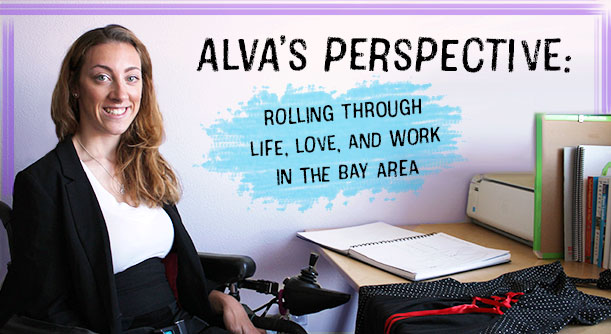It’s A Wonderful (Apartment) Life: Apartment Living 101
December 1st, 2013
by Alva Gardner
Welcome back to the conversation of independent living, transition to college life. This post will focus on, apartment life! I ended the last post saying that the key to independence is defining what that means to you, where your priorities are, and how you want to achieve independence. There is a misconception in our society that “independence” means someone does everything for him or herself and relies on no one. Instead, independence should be defined by each individual, for each individual; if you feel you are managing our life the way you want, you are an independent person.
That being said, this is how I choose to structure my independence. The most important part of independence for me was not to move home after I graduated from college. Mom and I discussed it throughout my final year at Cal, and we both decided that my moving back home would tempt us into old habits and make my inevitable permanent departure that much harder (for both of us). Thus, I now live in an apartment. Despite my lack of job and financial independence at this point, having a space and life separate from my mom has helped keep me motivated towards further independence. Here is a perfect first example of self-defined independence; I live separate from Mom, but she pays my rent. Despite this financial support, my relationship with Mom is not really any more dependent than my able-bodied counterpart.
And now to turn my full attention to apartment logistics. A shocking reality of accessible apartments is their rent — my apartment is $2075 a month for a 2 bedroom/1 bathroom. This was on the cheap end of the spectrum; most of the apartments I looked at (which I found by merely Googling “bay area wheelchair accessible apartments”) ranged from $2075/mo to $2700/mo. In total, I looked at 5 apartment complexes: 3 in Berkeley, 1 in Oakland, and 1 in El Cerrito (which had the cheapest rent in the high $1000s/mo). I should also mention that, because I am the roommate who needed the accessibility aspect of the apartment, I pay a little over half of the rent. I live with two roommates who divide the remainder equally between them.
When I say “accessible,” I merely mean an apartment that someone in a wheelchair can physically get into and move around. Most complexes do not have units that come with other desired accessibility features eg. grab bars, automatic door openers, etc. You may also have to have furniture removed or exchanged, kick plates installed on doors, and existing shelving reconfigured or removed. While touring places, I made sure too ask every complex what their protocol was for accommodations; most will pay for them once you request them (some require that you find a company to do the installation). The complex I live in, for example, had me fill out an application for all the requested accommodations, get it approved and signed by my doctor, and then find the exact pieces of equipment I wanted.
I started using personal care attendants full-time when I began at Cal. These are people who help me with daily living activities. In college, they helped with dressing, grooming, using the bathroom, showering, and eating breakfast. UC Berkeley is unique in that it has the Disabled Students’ Residence Program, designed for incoming freshmen to teach and assist with independent living skills; this is where I started learning how to hire, train, and manage my personal attendants. Since moving into my apartment, my attendants’ responsibilities have expanded to include more household chores, such as laundry, cleaning, and some secretarial duties. Depending on your needs, the attendant, and the level of communication, attendants’ duties can (and often do) vary.
The most difficult adjustment for me to apartment life was figuring out meals, grocery shopping, and then meal preparation. I hired a cook attendant; because none of my daily attendant shifts are long enough (or flexible enough) to allow for weekly dinner preparation, I had to make this its own shift. My cook attendant comes every Monday for 1.5 to 2 hours, cooks two dishes (which usually makes about five or six servings), cuts the food into bite-size pieces, and puts each serving in a Tupperware in my fridge. This way I have a balanced meal already prepared, which I can retrieve and eat independently.
Specific meal planning might vary widely person-to-person based on dietary restrictions and individual preference. That being said, some general strategies I’ve developed for meal planning include making lists (mentally or tangibly) of meals that I like and that I know work for me. For example, dishes with chicken or other meat that can be poked with a fork, pasta (for the same reason), and foods high in iron were important for me to base meals around. When I wanted to expand my menu repertoire, I looked to websites like www.williams-sonoma.com, www.bonapetite.com, and www.sunsetmagazine.com for recipes. Also, websites like www.yummly.com and www.pinterest.com (which I primarily use) allow me to make profiles where I can create “Boards” based on different interests, search for and save recipes, and get personalized recommendations. Now, once a week, I look at these websites, find one or two recipes that look good, and make grocery lists based on the ingredients.
I primarily do my grocery shopping at Safeway on Shattuck Ave. in the “Gourmet Ghetto”. It is a relatively short roll from my apartment, it has a wide variety of food, and it is decently priced. Safeway also has a great Rewards program, which saves me money. When I go shopping, I go by myself; I time it so that I get home when one of my attendants is scheduled to be there, then they are able to help me unload my groceries. Safeway, like most big chain grocery stores, has a Customer Service desk near the front of the store. Upon arriving, I go to Customer Service and request shopping assistance – one of the employees will come with a shopping cart and help. This is a service that anyone needing special assistance can request.
There are several city organizations in Berkeley and around the Bay Area that provide independent living skills training and assistance. Please refer to their websites for more information on services and eligibility.
The Berkeley Center for Independent Living: www.cilberkeley.org
The Regional Center of the East Bay: http://www.rceb.org
Clausen House: http://www.clausenhouse.org
Thanks for reading! Hope this helps appease some of your concerns.




Thank you for your comment! What type of additional information would you like?
Posted on January 14th, 2014
Like what kinds social bookmarking buttons?
Posted on January 15th, 2014
Thank you
This is all from personal experience
Posted on January 15th, 2014
you would need to contact United Cerebral Palsy of the Golden Gate to get their web designer
Posted on January 16th, 2014
Sure. Please credit my name, though
Posted on January 18th, 2014
Leave a Comment